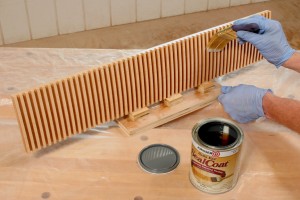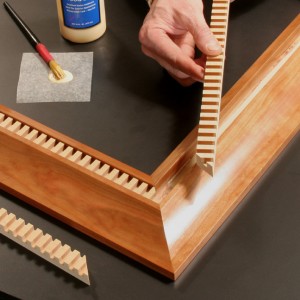
By now you may have read my Dentil Picture Frame article that’s running in the fold-out portion of the December 2009 issue (page 23). But, I wasn’t able to tell you everything I wanted to about the project…our pages will only fit so much.
So, for those of you who may have one of these frames earmarked for the holiday project gift list, here’s a little trick I used for finishing the maple dentil. Before I ripped the larger blank into narrower strips, it seemed like a smart time to apply finish. That way, I knew I could avoid having to pull excess finish out of the recess where the dentil sets into the frame. It was definitely the right call here. (I try to dodge every finishing headache I can!)
To hold the blank for finishing, I brad-nailed three little spacers to a larger scrap of plywood to serve as a base. Then, I attached the dentil blank to the spacers with three blobs of hot-melt glue. Tipping the dentil upright would let gravity work in my favor: excess finish could drain to the bottom of the strip where it wouldn’t matter. I’d just trim this messy edge off later.

Next came the bigger question of what finish to use and how to apply it. I suspected that an aerosol would just cause more trouble, laying down too heavily on the surface of the little tabs and too sparingly in the nooks and crannies. So, spray was out. A wipe-on finish was another option, but there was a good chance that lint from the rag would get trapped down in the pattern…another clean-up hassle. So, I opted for brushing. To keep the maple nice and blonde-colored, I reached for Zinsser clear shellac Sanding Sealer. This product, in my book, is a “must have” for many different applications:
http://www.zinsser.com/product_detail.asp?ProductID=72
It’s thin and cures fast. And since each coat of shellac “burns in” to the layer beneath it, I knew I’d get a smooth overall result.
Long story short, this approach worked really well. A little scuff-sanding between coats with 320-grit paper, and my dentil was ready for glue-up in just a few hours. Two coats did the trick. Be sure to pick the dentil up by the base every so often while brushing so you can inspect all the surfaces as you work. It’s easy to miss a spot.
Hope this helps!
Catch you in the shop,
Chris Marshall, Field Editor





